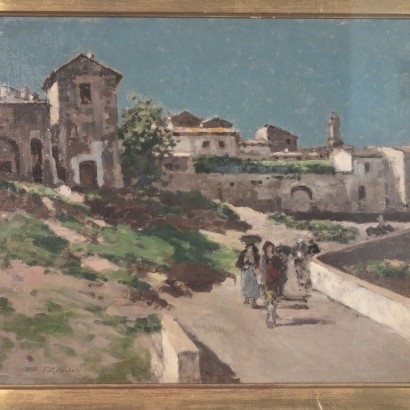Francesco Paolo Michetti, Oil on Canvas, 19th century - City Glimps with Figures
Features
Artist: Francesco Paolo Michetti (1851-1929)
Artwork title: Scorcio di paese con figure
Age: 19th Century / 1801 - 1900
Subject: Views/City Glimpses
Artistic technique: Painting
Technical specification: Oil on Canvas
Description : Scorcio di paese con figure
Oil on canvas. Signed on the lower left corner. The glimps of the village is seen from an external street where some popular figures are walking on the bridge; we can deduce that the place is close to the coast thanks to the brightness of the white houses and the light blue sjìky. Michetti was born in Abruzzo, studied painting at the Academy of Fine Arts in Naples where he built his realistic and naturalistic style, but the rural Abruzzo with its uncontaminated nature had always his main source of inspiration. The restored painting is displayed in a frame.
Product Condition:
Very good condition. Wear consistent with age and use. It may have been restored by an expert.
Frame Size (cm):
Height: 50
Width: 55
Depth: 7,5
Artwork dimensions (cm):
Height: 31
Width: 36
Additional Information
Artist: Francesco Paolo Michetti (1851-1929)
Francesco Paolo Michetti was born in Tocco da Casauria in 1851. He graduated from the Academy of Fine Arts in Naples, where he was a student, with Edoardo Dalbono, of the master Domenico Morelli, whose naturalism and visionary realism he initially imitated: a promising young man, his work was also immediately noticed by Filippo Palizzi, his countryman, who lived in Naples in those years. Like many painters of the time, since 1871 Michetti had also been interested in photography, initially only as a procedure for studying the subjects of his paintings from life, then also as a new and autonomous means of expression, also making use of direct graphic interventions on them photographic matrices. Rural Abruzzo, with its still uncontaminated nature, was always his main source of inspiration. Already in 1872 and then in 1875 he exhibited his works at the Paris Salon, but he was acclaimed, reaching definitive international fame, in 1877, when he exhibited the sensational canvas of Corpus Domini (purchased by Emperor Wilhelm II of Germany) in Naples. . In 1898 he participated in the Italian General Exhibition. Michetti was also the inspirer and initiator of an artistic circle of national importance which took its name from him and which, starting from the 1880s, began to meet in the convent of Santa Maria del Gesù in Francavilla al Mare, which the painter had purchased and which today is known as the Michetti Convent. Among the most representative men of letters, artists and men of culture who frequented it were Gabriele D'Annunzio, Francesco Paolo Tosti, Basilio Cascella, Costantino Barbella, Edoardo Scarfoglio, Matilde Serao, Antonio De Nino, Francesco Saverio Altamura. In 1903 he was indicated by Queen Elena of Montenegro as suitable for the production of some sketches to illustrate the cartoons of a series of stamps. From these sketches a stamp was then created, issued on 20 March 1906, which depicted the effigy of Vittorio Emanuele III facing to the right. For this reason the stamp was nicknamed Michetti on the right. The painter's international celebrity was such that Vittorio Emanuele III, on 4 April 1909, decided to appoint him Senator of the Kingdom. Michetti died in March 1929 in his convent in Francavilla.
Age: 19th Century / 1801 - 1900
19th Century / 1801 - 1900
Subject: Views/City Glimpses
Artistic technique: Painting
La pittura è l'arte che consiste nell'applicare dei pigmenti a un supporto come la carta, la tela, la seta, la ceramica, il legno, il vetro o un muro. Essendo i pigmenti essenzialmente solidi, è necessario utilizzare un legante, che li porti a uno stadio liquido, più fluido o più denso, e un collante, che permetta l'adesione duratura al supporto. Chi dipinge è detto pittore o pittrice. Il risultato è un'immagine che, a seconda delle intenzioni dell'autore, esprime la sua percezione del mondo o una libera associazione di forme o un qualsiasi altro significato, a seconda della sua creatività, del suo gusto estetico e di quello della società di cui fa parte.
Technical specification: Oil on Canvas
The oil painting is a painting technique using powder pigments mixed with bases in inert and oils. 



















